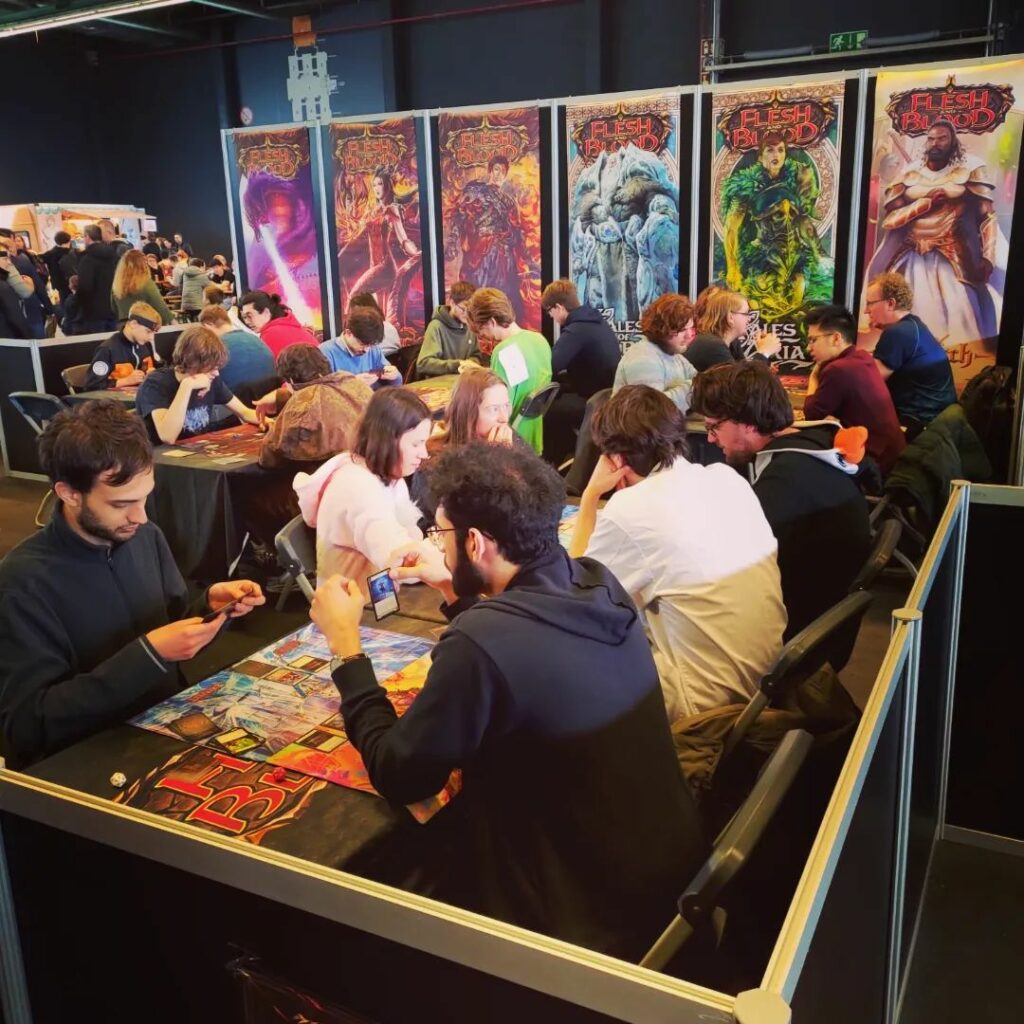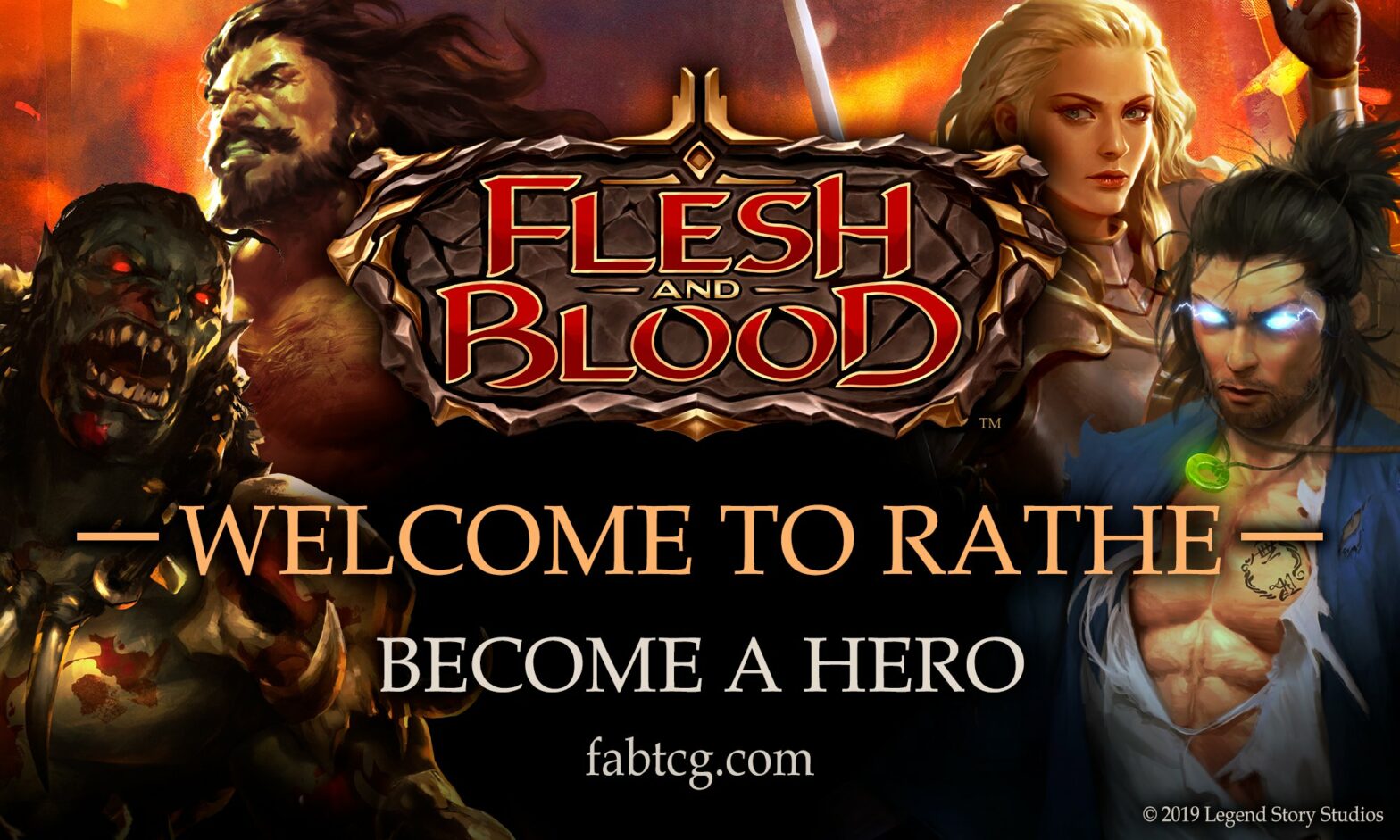You'll love it if:
- You like strategic card games
- You enjoy meeting with friends to play games
- You love deep mechanics and having agency in your gameplay
Not for you if:
- You dislike TCGs or card games in general
- You prefer online games over physical
Flesh and Blood is an innovative new card game from Legend Story Studios based in Auckland, New Zealand. Flesh and Blood is a personal passion of mine and I love being able to write about this game. One key feature that stands out to me is how in-depth the gameplay is, and how vast the decision trees for every in-game choice are.
What is Flesh and Blood?
The game saw its release in late 2019 shortly before the onset of the Covid pandemic. With Flesh and Blood’s mission statement being “to bring people together in the flesh and blood through the common language of playing great games”, this caused the game to go through quite a slow start. It began seeing play in New Zealand and Australia, slowly expanding into Singapore and other Southeast Asian countries. It was not until 2021 that the game really began seeing widespread play in Europe and North America.
Now, Flesh and Blood sees play at over 3000 stores worldwide and has organized play events ranging from local weekly meetups to professional events with prize pools up to $100,000. The player base is only growing and Flesh and Blood has solidified itself as one of the “big four” in the trading card game industry, alongside Magic The Gathering, Pokémon, and Yu-Gi-Oh. Flesh & Blood has amazing game mechanics, and really there is only one thing left to ask. How do you play Flesh & Blood?

Why You Should Play Flesh and Blood
Before diving into the rules of Flesh and Blood, I feel it is important to talk about why I love this game and why you should definitely give it a try. In my opinion, Flesh and Blood has something for all levels of players.
For the newer players, the community really helps teach the game and helps catch players up to speed. When I first learned the game, it was just with a friend of mine and we came across Flesh and Blood online. After going to a local game store, we felt really welcomed and people rushed to help us learn the game and build decks. Now that I have been playing for two years, I now take on the role of helping new players and growing the community. Even after moving to a new country, this was a hobby that helped me find friends and connect with people after a big move.
For more competitive players, Flesh and Blood has an amazing competitive structure for organized tournaments. At the local level players can attend weekly events at their stores. These “Armory” events are casual competitions to meet up and play with friends. Events go from small tournaments to qualifiers for national championships. For Magic The Gathering players, Flesh and Blood has events called Callings, equivalent to an MTG Grand Prix, as well as their own Pro Tours.
Players can even qualify for the World Championship, a yearly event where the winner can win $100,000. Flesh and Blood is a great game to pick up and play, meet with community members, and make friends, and for aspiring competitive players, offers a great circuit of professional events to work towards.
How Do You Play Flesh and Blood?
In Flesh and Blood, you play as one of several different characters. LSS has created very simple Learn to Play decks to teach people how the game works and demo the game to new players. For the sake of this tutorial, we will also utilize cards from the learn-to-play decks. The hero we will be using to learn how to play is Ira, Crimson Haze. She is a ninja hero with an intellect value of four and 20 health. She has a unique hero ability as well which we will get to in a moment.
You begin the game with your hero and weapon on the field. The goal of the game is to reduce your opponent’s life to zero. Additionally on your hero card is your intellect score. This is how many cards you begin the game in hand, and how many cards you draw up to at the end of each turn. In this case, Ira has an intellect of four, therefore at the end of each of your turns, you draw until you have four cards in hand.


What Makes a Card: How to Read a Flesh and Blood Card
With that in mind, how does a player go about reducing their opponent’s life total? This is usually done by attacking your opponent, either with “Attack Action Cards” or by activating your weapon’s ability to attack your opponent. When attacking with a card there are various constraints to keep in mind. We will use the diagram below to help explain what each card does, what the symbols represent and go through how to play each card.

The first criterion when playing a card is checking how much the card costs. The card above, “Torrent of Tempo,” costs one resource to play. You can see how many resources a card costs by looking in the top right corner. Cards can also produce resources by “pitching” said cards. The number of resources you get will appear in the top left corner.
In this case, Torrent of Tempo gains you one resource when pitched. We will cover what happens to pitched cards in a moment. When you attack with Torrent of Tempo, it attacks for 5 power as denoted in the bottom left. Finally, when this card is used to defend against an attack, it blocks three damage as denoted in the bottom right.
The second criterion when playing a card is to see how many “Action Points” you have. Typically, when your turn starts you have one action point. When you play an attack, you use your action point and your turn ends. The exception here is if your card has “go again.” Many cards in the game have “go again.” In Flesh and Blood, when you play an attack with go again, after the attack resolves, you may play another attack or do another action.
The card above, Torrent of Tempo, has a conditional go-again clause. It says “If Torrent of Tempo hits, it gains go again.” This means, if your opponent fully blocks this attack, it does not get go again, and your turn is typically over. But if it does hit, the go again happens and you as the attacking player may attack again.
The Arena: Flesh and Blood’s Layout
Before going into playing the actual cards, we need to first look at how the play space is organized. Luckily, many Flesh and Blood playmats contain zones clearly marked to describe what cards go where. The diagram below will help with explaining the different zones.

The first things to note are the Hero and Weapon zones. You begin the game with your hero and weapon(s) on the field. You also begin with your chosen Head, Chest, Arms, and Legs equipment pieces as well. After cards are played or used to block, they go to the graveyard unless otherwise specified. You Deck goes in the deck zone. When you pitch a card to gain resources, it goes into the pitch zone. In Flesh and Blood, you pitch cards to pay for costs, and at the end of each turn, cards in the pitch zone are placed onto the bottom of the deck.
Playing Your Turn
On your turn, you may play an attack or non-attack action card to fight your opponent. You may also activate your weapon to attack as well. Let’s say your hand contains the four cards below. Head Jab, Torrent of Tempo, Lunging Press, and Salt the Wounds. For example, you may activate your weapon, by paying one resource.
To pay for this cost, you put head jab into the pitch zone, which pays for the one resource required to attack with your weapon, and then leave you with two remaining. Your opponent has a chance to block, but they do not. The damage is dealt, you get go again from the weapon, and you may attack again.




After the sword, you may attack with the Torrent of Tempo. You have two resources left over, so you may play Torrent of Tempo and remove one resource from your remaining resources. Here is where Ira’s ability triggers and you gain plus one damage. Torrent of Tempo is now attacking for six damage. Your opponent does not want this to hit so they block for a full six. You on the other hand wish to play your Salt the Wounds after but you cannot unless Torrent of Tempo hits so you can gain the go again.
In your hand, you have Lunging Press, an attack reaction. After your opponent has blocked you proceed to the reaction step. You, the attacker, may play an attack reaction, and you do. You play Lunging Press targeting torrent of tempo, bringing it to 7 attack power. Your opponent does not want this to hit, so they play from their hand, a defence reaction, increasing their defence power. You could play another attack reaction if you wish but you have not got one. Torrent of Tempo is blocked, and your turn is over.
At the end of the turn, all non-weapon cards on the field go to the graveyard, and your weapon goes back to the weapon zone. You may put Salt the Wounds into your arsenal now if you wish. The arsenal is a zone where at the end of your turn if it is empty, you may put a card in the arsenal. Cards here cannot be used to pitch and cannot be used to block. These can be played, however. Defence reactions can be played from here to block. You put Salt the Wounds into your arsenal and draw up to your hero’s intellect, until you have four cards in hand, and pass to your opponent’s turn.
Ending the Turn: Should You Play Flesh and Blood?
Flesh and Blood offers unique gameplay and a wonderful in-person play experience. Should you just want to try out the game and play with friends, or test your mettle against the best of the best, this is a game for you.
I believe this game is definitely worth the time, and as opposed to other card game companies, Legend Story Studios really puts the player first. They want to make the player experience as fun as possible. If this game does pique your interest, stay tuned for more articles about heroes, tactics, and general Flesh and Blood news. You can also read about our experience in the early days of Flesh and Blood when Monarch was just released.
